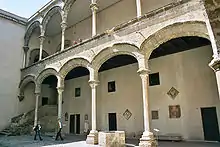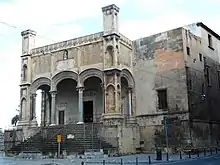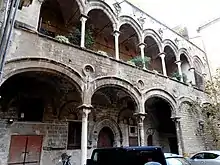
Courtyard of the Palazzo Abatellis

Santa Maria della Catena

Courtyard of Palazzo Aiutamicristo
Matteo Carnilivari or Carnelivari was an Italian architect active mainly from 1487 to 1493 in Palermo, Sicily.[1]
Biography
The notable architect of 15th-century Sicily is known for works that show the influences of International Gothic with Norman-Swabian motifs influenced by Catalan art and of the new Renaissance style.[2]
Among his main works are two palaces in Palermo: the Palazzo Abatellis built 1487 - 1493 with a medieval side-tower and the Palazzo Aiutamicristo built 1490 - 1495 with its Spanish-style courtyard. The design of the church of Santa Maria della Catena has been attributed to him by its similarities with his other designs.[3]
Designs
- Castello Chiaromontano or castello dell'Emiro (1487-1488) in Misilmeri, owned by Guglielmo Ajutamicristo.[4]
- Madonna della Vittoria church: rebuilt in 1488, and now part of the Oratorio dei Bianchi complex.
- Regia Cancelleria (1489) head of completion works.[5]
- Palazzo of the baron of Sant'Angelo Muxaro (1490) in Agrigento.
- Castello Vvevo (1494) in Augusta, Italy, headed restoration works[6]
References
- ↑ (in Italian) Trecanni entry
- ↑ (in Italian) M. R. Nobile (ed.), Matteo Carnilivari. Pere Compte. Due maestri del gotico nel Mediterraneo, Palermo, Edizioni Caracol, 2006, ISBN 88-89440-08-2.
- ↑ (in Italian) Le Muse, vol. 3, Novara, De Agostini, 1965, page 97
- ↑ (in Italian) Filippo Rotolo, Matteo Carnilivari. Revisione e documenti, Palermo, 1985, ISBN 978-0-00-101216-5.
- ↑ (in Italian) Filippo Meli, Matteo Carnilivari e l'architettura del Quattro e Cinquecento in Palermo, Roma, 1958.
- ↑ (in Italian) Salvatore Cardella, L'architettura di Matteo Carnalivari, Palermo, 1936.
This article is issued from Wikipedia. The text is licensed under Creative Commons - Attribution - Sharealike. Additional terms may apply for the media files.